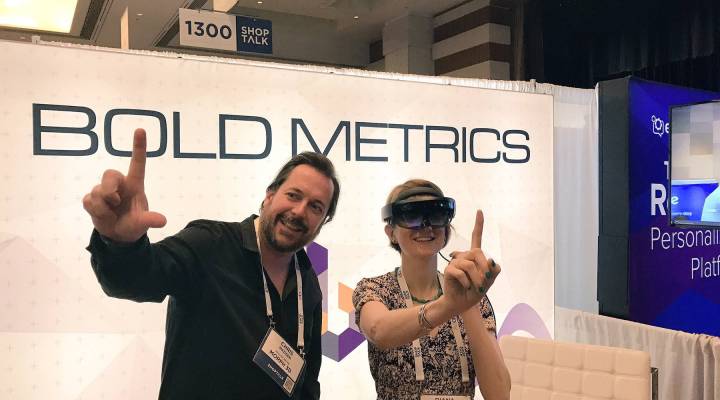
How augmented reality can improve shopping

Retail is struggling. Macy’s, Abercrombie & Fitch, The Limited and American Apparel are just a few retailers that have been closing stores recently. One reason is that shopping online is simpler. So, companies are turning to technology to make shopping better and more futuristic. Two companies, Bold Metrics Inc. and Morph 3D recently partnered up to use new virtual and augmented reality technology combined with a virtual map of your body to let you try on clothes in the digital world, in stores or at home. Host Molly Wood spoke to Bold Metrics Chief Operating Officer Morgan Linton. Below is an edited version of their conversation.
Molly Wood: So, let’s start at the top with the easy stuff. What does Bold Metrics do?
Morgan Linton: Yes, so, at Bold Metrics, we’ve built an AI technology built upon one of the largest data warehouses of human body measurements. Which means we can ask some very simple questions for consumers, things like their height, their weight, their age, their shoe size. And if they can answer those questions, we can actually predict over 90 body measurements at literally a higher level of accuracy than you could probably measure yourself.
- RELATED: Museums embrace virtual reality
- Oculus pop-up closings signal trouble in virtual reality market
- ‘Indefinite’ uses virtual reality to show detained immigrants’ despair
Wood: And where does all that data come from? Like, TSA scanners?
Linton: No, I wish we could get that data! A lot of people said, “You should get data from the TSA.” Something tells me they may not be the most interested in sharing that data with us. So, we’re partnering with private companies that have body scanners in gyms, or in shopping malls, research institutions that actually run very large representative studies in particular countries. So, we have actually a geographic body distributions for North America and Europe and other parts of the world. But then, once you get the data, you have to align it. So we actually have three Ph.D. data scientists on our team that work to take that data in, align the data sets together to be able to feed into the ML algorithm that we have.
Wood: And then tell us about this new partnership then with Morph 3D and how you are using that.
Linton: I’m really excited about this. So, they can make very realistic humanoid avatars. You know, if you have an avatar that you create, a shopper or a consumer that’s using our technology can literally just answer our standard question set and it instantly generates an avatar that’s a true-to-life avatar. So then if you see clothing on that avatar, if that avatar is sitting on a couch, or sitting in a car, or trying a golf club. All those will be to scale so you could actually buy things in a AR or VR.
Wood: And so, like, I don’t know how old you are, but I grew up with a show called “Jem and the Holograms” where she basically just had an infinite holographic closet. And when I hear you talk, that’s what I’m thinking, and I’m stoked. Is this like my “Jem and the Holograms” closet coming to life?
Linton: Yes. You know, that future which seems so far off really is getting incredibly close right now. The technology has come very far in the last three to five years. And you know, we see a world where you’ll be able to sit in your living room and try on 20 or 30 different outfits and then literally speak to a [Microsoft] HoloLens or a similar AR device and say “Buy this outfit,” and then the next day it could show up at your doorstep without ever looking at a size chart or having to wonder, “Hey, what size am I in this?”
Wood: Let’s talk about the barriers to adoption for commerce. I mean, for one thing you’d have to get stores to adopt the technology top to bottom, right? Which sounds non-trivial and/or you’d have to get consumers to all have a HoloLens. It sounds like, although I’m excited about my jump in the “Holograms” closet, it actually isn’t that close.
Linton: Yeah, no, it’s a very good point. So, we’re definitely not there yet. These are the early days, and the solutions we’re providing are going to be used in-store, so that shoppers can come in and try on [cloths]. If you think about it, if you were to go, to say, a large apparel store or a large furniture store, and you wanted to try 20 or 30 different outfits or 20 to 30 different couches. That’s a time consuming thing. In an augmented reality world, you can do that in three or four minutes, but it has to all be set up in the store. Right now, it is very new, very much in its early stages. But for consumer adoption, it’s probably going to come once these are shipping with the smartphones themselves.
Wood: All right Morgan, I’m waiting for my holographic closet. Morgan Linton is co-founder and COO of Bold Metrics. Thanks Morgan.
Linton: It’s getting closer by the day. Thanks so much.
There’s a lot happening in the world. Through it all, Marketplace is here for you.
You rely on Marketplace to break down the world’s events and tell you how it affects you in a fact-based, approachable way. We rely on your financial support to keep making that possible.
Your donation today powers the independent journalism that you rely on. For just $5/month, you can help sustain Marketplace so we can keep reporting on the things that matter to you.












